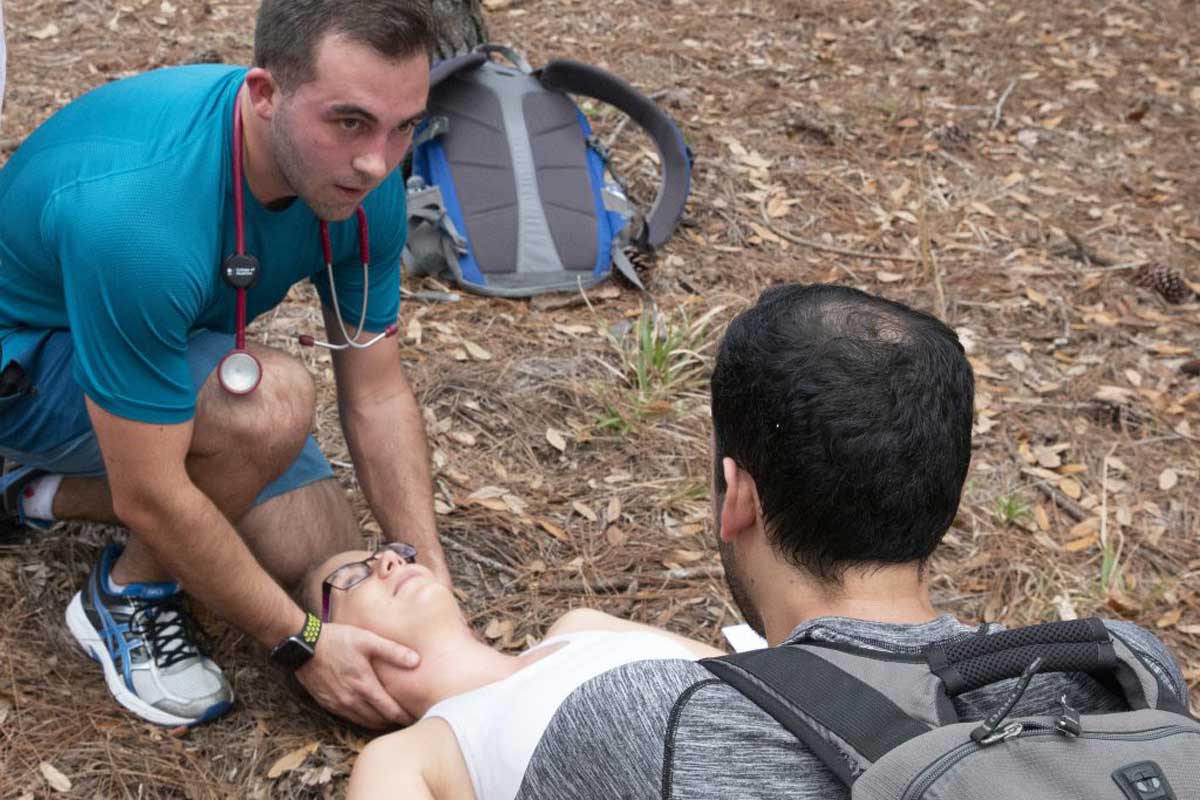Leia and Carolina Carrico have been making headlines across the country after rescue operations found the sisters, ages 8 and 5, safe in the woods two days after they lost their way near their home in Northern California.
The Humboldt County sheriff says training through 4-H may have helped them survive in the wilderness where the sisters say they drank water from huckleberry leaves and used a rain coat for shelter.
UCF medical students have been benefiting from similar training recently thanks to UCF’s chapter of the Wilderness Medical Society, a group devoted to educating physicians, residents and medical students on health safety in the outdoors. The group holds wilderness medical challenges across the country.
The group held such an event on Feb. 23 within the wooded confines of Southeast Orlando’s Moss Park where medical students hiked a 7.5-mile trail without the aid of maps and responded to wilderness emergencies, including an alligator attack, a broken bone and an allergic reaction to a bee sting.
“You just never know when you’re going to be faced with an emergency outdoors,” says second-year UCF medical student Brandon Marshall. “As a physician you have to be able to think on your feet when you’re tired. That’s why we wanted to bring this event to our medical school.”
“As a physician you have to be able to think on your feet when you’re tired. That’s why we wanted to bring this event to our medical school.” — Brandon Marshall, UCF medical student
Marshall participated in a similar event in the foothills of Georgia last year and came away impressed with the combination of testing participants’ physical endurance and medical knowledge. So he organized this year’s event.
Marshall is no stranger to grueling physical activity. He was a Greco-Roman wrestler who competed worldwide before coming to medical school. Marshall points out that Florida has more than 8,900 miles of hiking trails and 5,200 miles of bicycle trails, so there are plenty of opportunities for illness and injury to happen in the wilderness.
Students faced six of those real-life scenarios during the training while fellow students served as patients.
In one scenario, a hiker was attacked by an alligator near the edge of a lake and dragged in, suffering head trauma and a broken, bleeding arm. In another scenario, a hiker was stung by a bee, had an extreme allergic reaction and couldn’t speak to tell rescuers what was wrong.
Martin Klapheke, assistant dean for medical education, whose hobby is mountain climbing, helped supervise the outdoor challenges.
“You could see the growth in communication and teamwork as each group worked its way from medical station to station,” he says. “Such teamwork is critical in medical care today.”
“You could see the growth in communication and teamwork as each group worked its way from medical station to station.” — Martin Klapheke, assistant dean for medical education
Dumas, a third-year medical student, said the Wilderness Medical Society event challenged students’ medical knowledge and their ability to work quickly as a team, especially in emergency situations when things can get hectic.
“It’s important to verbalize loudly what’s happening and what you’re doing – telling people, ‘I’m checking pulses,’ or ‘I’m checking breathing,’ ” he says.
Dumas says one of the most challenging scenarios involved a patient who had fallen out of a tree, breaking his pelvis and injuring his head. The patient complained of a stiff neck and spine pain.
“Both of those can be life-threatening emergencies. Which do you handle first?” Dumas says. “And that’s where the team dynamic came in. We had someone stabilizing the head, and we had somebody assessing neurologic status, and another team member checking pulses.
“Knowing how to keep calm, how to assess the situation and go from there, I think is what really makes you a great physician.”




